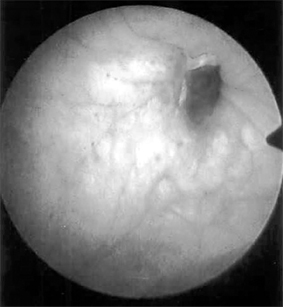Yonsei Med J.
2005 Dec;46(6):874-876.
Occult Intraperitoneal Bladder Injury after a Tension-Free Vaginal Tape Procedure
- Affiliations
-
- 1Department of Urology, Hallym University, KyungGi-do, Korea.
- 2Department of Urology, Inha University Medical College, Incheon, Korea.
- 3Department of Emergency Medicine, Inha University Medical College, Incheon, Korea.
- 4Social and Preventive Medicine, Inha University Medical College, Incheon, Korea.
Abstract
- Occult bladder injury may sometimes go unrecognized during tension-free vaginal tape (TVT) procedures. We report a case of occult intraperitoneal bladder injury that occurred during a TVT procedure. There was no sign of bladder perforation on the initial cystoscopy, which was performed just after the insertion of the trocar. Signs of general peritonitis appeared after the patient started to void the next day. A postoperative cystogram and cystoscopy showed an intraperitoneal bladder injury and a pinhead-sized ulcerative lesion in the right lateral wall of the bladder. We suspect that at the time of initial cystoscopy, the trocar passed through the submucosal area without violating the bladder mucosa. The occult bladder injury may have been caused after the initial cystoscopy by advancing the rough edge of the prolene tape during the extraction of the trocar. This report is the first description of such an occult bladder injury during a TVT procedure.
Keyword
MeSH Terms
Figure
Reference
-
1. Volkmer BG, Nesslauer T, Rinnab L, Schradin T, Hautmann RE, Gottfried HW. Surgical intervention for complications of tension-free vaginal tape procedure. J Urol. 2003. 169:570–574.2. Karram MM, Segal JL, Vassallo BJ, Kleeman SD. Complications and untoward effects of the tension-free vaginal tape procedure. Obstet Gynecol. 2003. 101:929–932.3. Walters MD, Tulikangas PK, LaSala C, Muir TW. Vascular injury during tension-free vaginal tape procedure for stress urinary incontinence. Obstet Gynecol. 2001. 98:957–959.4. Shobeiri SA, Garely AD, Chesson RR, Nolan TE. Recognition of occult bladder injury during the tension-free vaginal tape procedure. Obstet Gynecol. 2002. 99:1067–1072.5. Bai SW, Kim SH, Kwon HS, Rha KH, Chung KA, Kim SK, et al. Surgical outcome of female genital fistula in Korea. Yonsei Med J. 2002. 43:315–319.
- Full Text Links
- Actions
-
Cited
- CITED
-
- Close
- Share
- Similar articles
-
- Obturator Neuropathy Associated with Tension Free Vaginal Tape Procedure
- Vascular Injury Following Tension-Free Vaginal Tape in Stress Incontinence
- Surgical Treatment for Long Term Urethral Obstruction after Tension-Free Vaginal Tape Procedure
- The Effects of Simultaneous Vaginal Hysterectomy on the Outcomes of a Tension-free Vaginal Tape Procedure for Female Stress Urinary Incontinence
- Non-surgical Treatment of Voiding Dysfunction Following Tension-Free Vaginal Tape Procedure in Female Stress Urinary Incontinence




